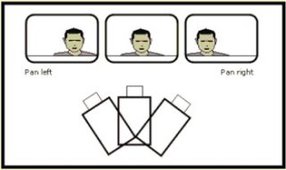I am using the rts cam script and was wondering if it was possible to stop the camera from going out of sight of an object. This set up is being developed in unity and is for a 3D game. The camera is being used to rotate, pan and zoom in/around an object. At the moment I can move out of sight of the object. Is there a way to block the camera from going out of sight of the object? I have seen multiple ways to keep an object in sight through the camera, however I am unsure which route to take.
I have attached the script being used below.
public class RTSCam : MonoBehaviour {
private float dist;
private float orbitSpeedX;
private float orbitSpeedY;
private float zoomSpeed;
public float rotXSpeedModifier=0.25f;
public float rotYSpeedModifier=0.25f;
public float zoomSpeedModifier=5;
public float minRotX=-20;
public float maxRotX=70;
//public float minRotY=45;
//public float maxRotY=315;
public float minZoom=3;
public float maxZoom=15;
public float panSpeedModifier=1f;
// Use this for initialization
void Start () {
dist=transform.localPosition.z;
DemoSceneUI.SetSceneTitle("RTS camera, the camera will orbit around a pivot point but the rotation in z-axis is locked");
string instInfo="";
instInfo+="- swipe or drag on screen to rotate the camera\n";
instInfo+="- pinch or using mouse wheel to zoom in/out\n";
instInfo+="- swipe or drag on screen with 2 fingers to move around\n";
instInfo+="- single finger interaction can be simulate using left mosue button\n";
instInfo+="- two fingers interacion can be simulate using right mouse button";
DemoSceneUI.SetSceneInstruction(instInfo);
}
void OnEnable(){
IT_Gesture.onDraggingE += OnDragging;
IT_Gesture.onMFDraggingE += OnMFDragging;
IT_Gesture.onPinchE += OnPinch;
orbitSpeedX=0;
orbitSpeedY=0;
zoomSpeed=0;
}
void OnDisable(){
IT_Gesture.onDraggingE -= OnDragging;
IT_Gesture.onMFDraggingE -= OnMFDragging;
IT_Gesture.onPinchE -= OnPinch;
}
// Update is called once per frame
void Update () {
//get the current rotation
float x=transform.parent.rotation.eulerAngles.x;
float y=transform.parent.rotation.eulerAngles.y;
//make sure x is between -180 to 180 so we can clamp it propery later
if(x>180) x-=360;
//calculate the x and y rotation
//Quaternion rotationY=Quaternion.Euler(0, Mathf.Clamp(y+orbitSpeedY, minRotY, maxRotY), 0);
Quaternion rotationY=Quaternion.Euler(0, y+orbitSpeedY, 0);
Quaternion rotationX=Quaternion.Euler(Mathf.Clamp(x+orbitSpeedX, minRotX, maxRotX), 0, 0);
//apply the rotation
transform.parent.rotation=rotationY*rotationX;
//calculate the zoom and apply it
dist+=Time.deltaTime*zoomSpeed*0.01f;
dist=Mathf.Clamp(dist, -maxZoom, -minZoom);
transform.localPosition=new Vector3(0, 0, dist);
//reduce all the speed
orbitSpeedX*=(1-Time.deltaTime*12);
orbitSpeedY*=(1-Time.deltaTime*3);
zoomSpeed*=(1-Time.deltaTime*4);
//use mouse scroll wheel to simulate pinch, sorry I sort of cheated here
zoomSpeed+=Input.GetAxis("Mouse ScrollWheel")*500*zoomSpeedModifier;
}
//called when one finger drag are detected
void OnDragging(DragInfo dragInfo){
//if the drag is perform using mouse2, use it as a two finger drag
if(dragInfo.isMouse && dragInfo.index==1) OnMFDragging(dragInfo);
//else perform normal orbiting
else{
//apply the DPI scaling
dragInfo.delta/=IT_Gesture.GetDPIFactor();
//vertical movement is corresponded to rotation in x-axis
orbitSpeedX=-dragInfo.delta.y*rotXSpeedModifier;
//horizontal movement is corresponded to rotation in y-axis
orbitSpeedY=dragInfo.delta.x*rotYSpeedModifier;
}
}
//called when pinch is detected
void OnPinch(PinchInfo pinfo){
zoomSpeed-=pinfo.magnitude*zoomSpeedModifier/IT_Gesture.GetDPIFactor();
}
//called when a dual finger or a right mouse drag is detected
void OnMFDragging(DragInfo dragInfo){
//apply the DPI scaling
dragInfo.delta/=IT_Gesture.GetDPIFactor();
//make a new direction, pointing horizontally at the direction of the camera y-rotation
Quaternion direction=Quaternion.Euler(0, transform.parent.rotation.eulerAngles.y, 0);
//calculate forward movement based on vertical input
Vector3 moveDirZ=transform.parent.InverseTransformDirection(direction*Vector3.forward*-dragInfo.delta.y);
//calculate sideway movement base on horizontal input
Vector3 moveDirX=transform.parent.InverseTransformDirection(direction*Vector3.right*-dragInfo.delta.x);
//move the cmera
transform.parent.Translate(moveDirZ * panSpeedModifier * Time.deltaTime);
transform.parent.Translate(moveDirX * panSpeedModifier * Time.deltaTime);
}
//for the camera to auto rotate and focus on a predefined position
/*
public float targetRotX;
public float targetRotY;
public float targetRotZ;
public Vector3 targetPos;
public float targetZoom;
IEnumerator LerpToPoint(){
Quaternion startRot=transform.parent.rotation;
Quaternion endRot=Quaternion.Euler(targetRotX, targetRotY, targetRotZ);
Vector3 startPos=transform.parent.position;
Vector3 startZoom=transform.localPosition;
float duration=0;
while(duration<1){
transform.parent.rotation=Quaternion.Lerp(startRot, endRot, duration);
transform.parent.position=Vector3.Lerp(startPos, targetPos, duration);
transform.localPosition=Vector3.Lerp(startZoom, new Vector3(0, 0, -targetZoom), duration);
duration+=Time.deltaTime;
yield return null;
}
transform.parent.rotation=endRot;
transform.parent.position=targetPos;
transform.localPosition=new Vector3(0, 0, -targetZoom);
}
*/
/*
private bool instruction=false;
void OnGUI(){
string title="RTS camera, the camera will orbit around a pivot point but the rotation in z-axis is locked.";
GUI.Label(new Rect(150, 10, 400, 60), title);
if(!instruction){
if(GUI.Button(new Rect(10, 55, 130, 35), "Instruction On")){
instruction=true;
}
}
else{
if(GUI.Button(new Rect(10, 55, 130, 35), "Instruction Off")){
instruction=false;
}
GUI.Box(new Rect(10, 100, 400, 100), "");
string instInfo="";
instInfo+="- swipe or drag on screen to rotate the camera\n";
instInfo+="- pinch or using mouse wheel to zoom in/out\n";
instInfo+="- swipe or drag on screen with 2 fingers to move around\n";
instInfo+="- single finger interaction can be simulate using left mosue button\n";
instInfo+="- two fingers interacion can be simulate using right mouse button";
GUI.Label(new Rect(15, 105, 390, 90), instInfo);
}
}
*/
}







